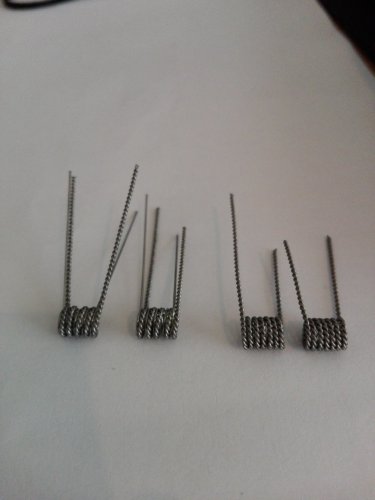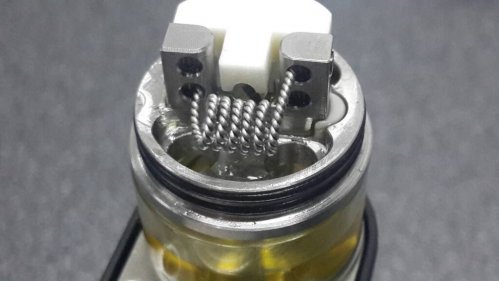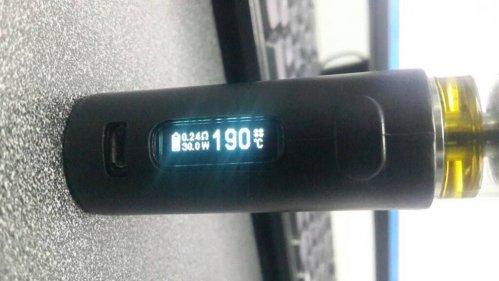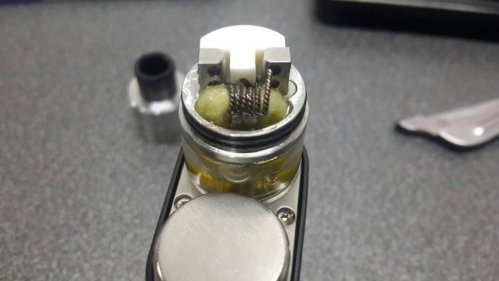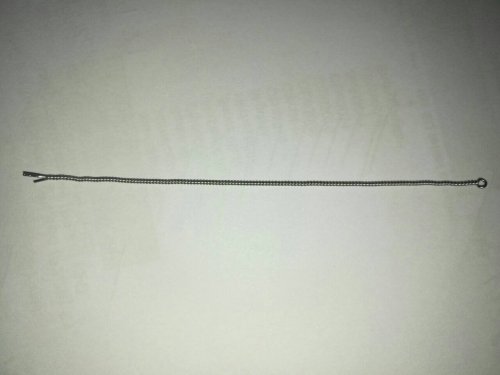Interesting. Why do you say the bigger ID will use more of the available internal airflow? To my mind the smaller ID (but wider coil) will be better cooled all round? The net effect might be the same due to the quicker heating up of the smaller ID coil.Haha, thanks for the shout @Silver! Glad its getting out!
I have that on my to-do list. Problem with vape-related research is you need the research atomizers for vaping as well... I'll have to scour the classifieds at some time for a few cheapies. I have some related data, but will keep that together for a bigger post.
But I've been speculating, and based on what I've seen thus far:
I agree 100% with you, @Silver.
If we compare two coils with the same material (28 AWG Kanthal), the same number of wraps (6), but different inner diameters (2mm and 3mm), and therefore different resistances (1.0 ohm vs 1.345 ohm):
In addition, smaller coils have more constructive/destructive interference when heating - in other words, all parts of the wire is closer to each other, therefore heating one part of the coil causes its neighbouring parts to be heated more, which causes the original part to be heated even more, which causes its neighbouring parts to be heated even more more... you get the idea.
- The 3 mm coil will (when stretched out) be longer (75.11 mm vs 55.85)
- Hence, it will have different surface area's (70.73 vs 51.92 mm2)
- Hence, it will have a lower heat flux (1.32 vs 1.78 Watt/mm2)
- Hence, it will require more power to heat up
- It will be able to wick more juice at a time
- It will utilize more of the available internal airflow
So we see that, with two coils with the same width (ie, same number of wraps), but larger ID, the larger ID coil will take more power to heat up to the same level. However, if you give it more power and get it to the same temperature as a coil with a smaller ID, you'll produce more vape since you've got more of the coil in contact with the juice.
The last two points in the above list I'll get to a bit later.
On the other hand, if we compare two coils in the same manner as above, but instead of keeping the number of wraps constant, we keep the resistance constant (@ 1 ohm), we see the following:
- Both coils will be the same length when stretched out (55.85 mm)
- The larger ID coil will have slightly fewer wraps (~4 instead of ~6)
- Hence, the surface area will remain identical (51.29 mm2)
- Hence, the heat flux will remain identical (1.78 watt/mm2)
- Hence, both coils will take the same amount of power to heat up
- The higher ID will wick more
- The higher ID will utilize more of the available internal airflow
The constructive/deconstructive interference I talked about above still applies here (in other words, due to the wires being closer to each other, will lead to quicker heating) - but I don't actually know how big an effect that is. My research thus far shows that it is not at all, and that the differences because of this effect comes down to fractions of a second. But it is there, either way.
Looking at the list above, we see that if we have two coils with different ID's but the same resistance, they will take the same power to heat up to the same temperature. The only difference between the two coils will be the last two points:
Lets scratch the first one, and assume our wicking technique is even better than Zeus', and that both of our coils wick fast enough for the power we are throwing at them. Now, we are left only with the last point, but arguably the most important one.
- The higher ID will wick more
- The higher ID will utilize more of the available internal airflow
If we have two coils with the exact same physical properties (in terms of how much power it requires to heat up), the larger one relative to the airholes (as well as how the air flows inside the atty) will be cooled more, which generally means more vape - depending on our setup.
For instance, lets say we take the two identical resistance coils from above, and throw 40 W at each of them while drawing as hard as we can. The smaller ID one will reach say 220 Celcius, at which point the airflow across the coil cools the coil almost as fast as the electricity is heating the coil, and the temperature remains more or less constant. On the other hand, with the 3mm coil and at 40 W, there will (usually) be more airflow across the coil, so it is cooled more, despite having the same heat from the electricity (since the two coils' physical properties are identical). So this coil might max at around 200 Celcius, maybe, and therefore produce less vapour. But that means we can bump up the power to 50 W using this coil - despite the fact that both coils heat up at the same tempo - because we have more cooling, and overall we'll produce more vapour at the same temperature in the bigger ID.
Unfortunately, things aren't always that simple. Using a larger coil (and more wick, accordingly) might mean that you'll be blocking of some of the indirect airflow, which can help cool the atty, create bigger clouds (albeit slightly less dense), and cool the final airflow, giving a cooler vape. In addition, a larger coil can actually mean blocking off the route air would take which would give maximum exposure to the coil, and rather force air to follow pathways which give less cooling and less vape. Or it might mean breaking a vortex effect.
In summary, I have found the following regarding coil size. These are mostly still heuristic, but I'm working on backing these up with experimental data:
- Larger coils equals more power equals more vape
- Usually, larger coils gives me an overall larger vape
- Usually, larger coils heats up my atty and mod more
- Too large a coil will give airflow problems - it will get hot too quickly but with very little vape, and the atty will heat up immensely
- Larger coils tends to give me less crisp flavour (not always though, and not necessarily less flavour)
So all in all, I'll say what I always say - larger/smaller isn't better/worse, it will only depend on the atty. Certain atty's like smaller coils, certain atty's like bigger coils.
Btw, in terms of the electrical properties.... I haven't found any difference in any resistance range. As long as you stay safe, and you're mod is more than capable putting out higher voltage for higher resistance builds, I haven't found any difference in vapour/flavour production based on resistance, if the physical properties of the wires (heat flux, heat capacity ect) remains the same. So you don't necessarily have to think higher resistance means more voltage means super-fast moving electrons which will blow the crap out of that poor little Suicide Bunny - it generally is all the same, as long as the power (W) is the same. I think some of the pervasive ideas that lower resistance equals more vapour stems still from the days before variable voltage or variable wattage. At much very high or very low resistances there are some thresholds and funky patterns in terms of electricity flow and the thermodynamics of the material, but I believe these occur outside of vaping ranges.
That said, if you are building a high resistance build, just check whether your regulated mod and batteries can handle it - they can be as dangerous as a low-ohm build if your regulated mod doesn't have the correct safety features. And keep a watch on the mod's temperature - some mods can handle a high resistance build at high wattages only once, if you get what I'm saying.
Navigation
Install the app
How to install the app on iOS
Follow along with the video below to see how to install our site as a web app on your home screen.

Note: this_feature_currently_requires_accessing_site_using_safari
More options
You are using an out of date browser. It may not display this or other websites correctly.
You should upgrade or use an alternative browser.
You should upgrade or use an alternative browser.
Show us your Builds - Kayfun, Russians & Similar
- Thread starter devdev
- Start date
Interesting. Why do you say the bigger ID will use more of the available internal airflow? To my mind the smaller ID (but wider coil) will be better cooled all round? The net effect might be the same due to the quicker heating up of the smaller ID coil.
You're right, smaller ID will be better cooled than bigger ID. I meant bigger ID will utilize more of the available internal airflow.
You're making me doubt some of my statements now, and I realize how big of an influence the actual airflow will be within an atty. Two coils with the same resistance but different IDs have the same surface area, and will therefore be exposed (in a totally open system) to exactly the same airflow. However, the one with the smaller ID will be longer in length (more wraps), whereas the one with the bigger ID will be bigger in width/height. Depending on the airflow, one coil might be significantly more cooled than the other. For instance, in cyclops style airflows, the smaller ID coil (but with more wraps) will be exposed to more direct air by virtue of covering the entire cyclops. On the other hand, very focussed direct airflow (such as on the Aromamizer) might benefit larger ID coils more, by virtue of more time in contact due to travelling around the coil. I'm heavily speculating here.
Thanks @Ezekiel
Its going to take me a while to digest that awesome post of yours in response to my shout out
Haha
And here I was thinking it had to do with the smaller ID having less juice inside the diameter, so the whole thing gets hotter! Didn't think of it in nearly as much detail as what you mentioned. You have given me homework now.
I do agree with your final heuristic findings.
My take on it has generally been like this:
Its going to take me a while to digest that awesome post of yours in response to my shout out
Haha
And here I was thinking it had to do with the smaller ID having less juice inside the diameter, so the whole thing gets hotter! Didn't think of it in nearly as much detail as what you mentioned. You have given me homework now.
I do agree with your final heuristic findings.
My take on it has generally been like this:
- lower power - use thinner wire, smaller IDs - crisper vape
- higher power - use fatter wire, bigger IDs - less crisp vape
Sorry bout that @Silver!Thanks @Ezekiel
Its going to take me a while to digest that awesome post of yours in response to my shout out
Haha
And here I was thinking it had to do with the smaller ID having less juice inside the diameter, so the whole thing gets hotter! Didn't think of it in nearly as much detail as what you mentioned. You have given me homework now.
I do agree with your final heuristic findings.
My take on it has generally been like this:
Obviously it's a gradual spectrum, not just two endpoints. I tend to spend more time near the first one.
- lower power - use thinner wire, smaller IDs - crisper vape
- higher power - use fatter wire, bigger IDs - less crisp vape
Agree totally with your general impression - thats mine as well! I also tend towards the 1st one more than the second, and I agree it tends to give a more crisp vape.
Sent from my SM-G920F using Tapatalk
Thanks for the feedback Silver, I'll rather wire it once I burn out my coil, really like the one in right now and I'm not gonna waste it xD. I'll post in a few weeks on using high guage macros in RTA setups for 20-30w.Hi @Zakariya Baker
My experience has been that the lower wattage is not good for bigger diameters.
The smaller the diameter the hotter the coil gets but the less wicking you have.
So i think (and this is just from my experiences) that the higher you go in power, the bigger the diameter of coil you can afford (from a temp point of view) and the bigger the diameter of coil you need from a wicking point of view - ie you need to carry more juice.
At lowish power - say up to 30 Watts i like my small diameters - like 1.6mm. On some devices i have to use 2mm because it needs more wicking. But at higher power, there isnt enough juice in the wick to have such a small diameter.
So my sense is that a 3mm ID with a lowish power vape on 28g wont be optimal. But try it out and let us know how it goes
This is some amazing analysis man. So what I've got prepped is more for the high guage high resistance, not bc I want the higher resistance, but bc I want good surface area on the coil. I keep it within the limit, so around 2-2.5ohm. So now I've got factors to consider of a high guage coil (28), larger surface are with macro ID (3mm). I understand I will be blowing my Atty with heat to match the heat capacity needed to power the coil, but it's more an experiment to get a big vape on low power, as well as to find out how flavour flave and heat flux consistency perform once I start chaining this thing. What do you think of the idea? Pointless fiddle or am I making some sense?.Haha, thanks for the shout @Silver! Glad its getting out!
I have that on my to-do list. Problem with vape-related research is you need the research atomizers for vaping as well... I'll have to scour the classifieds at some time for a few cheapies. I have some related data, but will keep that together for a bigger post.
But I've been speculating, and based on what I've seen thus far:
I agree 100% with you, @Silver.
If we compare two coils with the same material (28 AWG Kanthal), the same number of wraps (6), but different inner diameters (2mm and 3mm), and therefore different resistances (1.0 ohm vs 1.345 ohm):
In addition, smaller coils have more constructive/destructive interference when heating - in other words, all parts of the wire is closer to each other, therefore heating one part of the coil causes its neighbouring parts to be heated more, which causes the original part to be heated even more, which causes its neighbouring parts to be heated even more more... you get the idea.
- The 3 mm coil will (when stretched out) be longer (75.11 mm vs 55.85)
- Hence, it will have different surface area's (70.73 vs 51.92 mm2)
- Hence, it will have a lower heat flux (1.32 vs 1.78 Watt/mm2)
- Hence, it will require more power to heat up
- It will be able to wick more juice at a time
- It will utilize more of the available internal airflow
So we see that, with two coils with the same width (ie, same number of wraps), but larger ID, the larger ID coil will take more power to heat up to the same level. However, if you give it more power and get it to the same temperature as a coil with a smaller ID, you'll produce more vape since you've got more of the coil in contact with the juice.
The last two points in the above list I'll get to a bit later.
On the other hand, if we compare two coils in the same manner as above, but instead of keeping the number of wraps constant, we keep the resistance constant (@ 1 ohm), we see the following:
- Both coils will be the same length when stretched out (55.85 mm)
- The larger ID coil will have slightly fewer wraps (~4 instead of ~6)
- Hence, the surface area will remain identical (51.29 mm2)
- Hence, the heat flux will remain identical (1.78 watt/mm2)
- Hence, both coils will take the same amount of power to heat up
- The higher ID will wick more
- The higher ID will utilize more of the available internal airflow
The constructive/deconstructive interference I talked about above still applies here (in other words, due to the wires being closer to each other, will lead to quicker heating) - but I don't actually know how big an effect that is. My research thus far shows that it is not at all, and that the differences because of this effect comes down to fractions of a second. But it is there, either way.
Looking at the list above, we see that if we have two coils with different ID's but the same resistance, they will take the same power to heat up to the same temperature. The only difference between the two coils will be the last two points:
Lets scratch the first one, and assume our wicking technique is even better than Zeus', and that both of our coils wick fast enough for the power we are throwing at them. Now, we are left only with the last point, but arguably the most important one.
- The higher ID will wick more
- The higher ID will utilize more of the available internal airflow
If we have two coils with the exact same physical properties (in terms of how much power it requires to heat up), the larger one relative to the airholes (as well as how the air flows inside the atty) will be cooled more, which generally means more vape - depending on our setup.
For instance, lets say we take the two identical resistance coils from above, and throw 40 W at each of them while drawing as hard as we can. The smaller ID one will reach say 220 Celcius, at which point the airflow across the coil cools the coil almost as fast as the electricity is heating the coil, and the temperature remains more or less constant. On the other hand, with the 3mm coil and at 40 W, there will (usually) be more airflow across the coil, so it is cooled more, despite having the same heat from the electricity (since the two coils' physical properties are identical). So this coil might max at around 200 Celcius, maybe, and therefore produce less vapour. But that means we can bump up the power to 50 W using this coil - despite the fact that both coils heat up at the same tempo - because we have more cooling, and overall we'll produce more vapour at the same temperature in the bigger ID.
Unfortunately, things aren't always that simple. Using a larger coil (and more wick, accordingly) might mean that you'll be blocking of some of the indirect airflow, which can help cool the atty, create bigger clouds (albeit slightly less dense), and cool the final airflow, giving a cooler vape. In addition, a larger coil can actually mean blocking off the route air would take which would give maximum exposure to the coil, and rather force air to follow pathways which give less cooling and less vape. Or it might mean breaking a vortex effect.
In summary, I have found the following regarding coil size. These are mostly still heuristic, but I'm working on backing these up with experimental data:
- Larger coils equals more power equals more vape
- Usually, larger coils gives me an overall larger vape
- Usually, larger coils heats up my atty and mod more
- Too large a coil will give airflow problems - it will get hot too quickly but with very little vape, and the atty will heat up immensely
- Larger coils tends to give me less crisp flavour (not always though, and not necessarily less flavour)
So all in all, I'll say what I always say - larger/smaller isn't better/worse, it will only depend on the atty. Certain atty's like smaller coils, certain atty's like bigger coils.
Btw, in terms of the electrical properties.... I haven't found any difference in any resistance range. As long as you stay safe, and you're mod is more than capable putting out higher voltage for higher resistance builds, I haven't found any difference in vapour/flavour production based on resistance, if the physical properties of the wires (heat flux, heat capacity ect) remains the same. So you don't necessarily have to think higher resistance means more voltage means super-fast moving electrons which will blow the crap out of that poor little Suicide Bunny - it generally is all the same, as long as the power (W) is the same. I think some of the pervasive ideas that lower resistance equals more vapour stems still from the days before variable voltage or variable wattage. At much very high or very low resistances there are some thresholds and funky patterns in terms of electricity flow and the thermodynamics of the material, but I believe these occur outside of vaping ranges.
That said, if you are building a high resistance build, just check whether your regulated mod and batteries can handle it - they can be as dangerous as a low-ohm build if your regulated mod doesn't have the correct safety features. And keep a watch on the mod's temperature - some mods can handle a high resistance build at high wattages only once, if you get what I'm saying.
I am wondering what the relationship is between coil size and the size of the chamber they are in. Atty size. Like an average percentage of the atty's space being used by the coil before air flow problems start. If it is about chamber vs coil size it should be possible to start with some kind of standard when you get an atty right out the box.Haha, thanks for the shout @Silver! Glad its getting out!
I have that on my to-do list. Problem with vape-related research is you need the research atomizers for vaping as well... I'll have to scour the classifieds at some time for a few cheapies. I have some related data, but will keep that together for a bigger post.
But I've been speculating, and based on what I've seen thus far:
I agree 100% with you, @Silver.
If we compare two coils with the same material (28 AWG Kanthal), the same number of wraps (6), but different inner diameters (2mm and 3mm), and therefore different resistances (1.0 ohm vs 1.345 ohm):
In addition, smaller coils have more constructive/destructive interference when heating - in other words, all parts of the wire is closer to each other, therefore heating one part of the coil causes its neighbouring parts to be heated more, which causes the original part to be heated even more, which causes its neighbouring parts to be heated even more more... you get the idea.
- The 3 mm coil will (when stretched out) be longer (75.11 mm vs 55.85)
- Hence, it will have different surface area's (70.73 vs 51.92 mm2)
- Hence, it will have a lower heat flux (1.32 vs 1.78 Watt/mm2)
- Hence, it will require more power to heat up
- It will be able to wick more juice at a time
- It will utilize more of the available internal airflow
So we see that, with two coils with the same width (ie, same number of wraps), but larger ID, the larger ID coil will take more power to heat up to the same level. However, if you give it more power and get it to the same temperature as a coil with a smaller ID, you'll produce more vape since you've got more of the coil in contact with the juice.
The last two points in the above list I'll get to a bit later.
On the other hand, if we compare two coils in the same manner as above, but instead of keeping the number of wraps constant, we keep the resistance constant (@ 1 ohm), we see the following:
- Both coils will be the same length when stretched out (55.85 mm)
- The larger ID coil will have slightly fewer wraps (~4 instead of ~6)
- Hence, the surface area will remain identical (51.29 mm2)
- Hence, the heat flux will remain identical (1.78 watt/mm2)
- Hence, both coils will take the same amount of power to heat up
- The higher ID will wick more
- The higher ID will utilize more of the available internal airflow
The constructive/deconstructive interference I talked about above still applies here (in other words, due to the wires being closer to each other, will lead to quicker heating) - but I don't actually know how big an effect that is. My research thus far shows that it is not at all, and that the differences because of this effect comes down to fractions of a second. But it is there, either way.
Looking at the list above, we see that if we have two coils with different ID's but the same resistance, they will take the same power to heat up to the same temperature. The only difference between the two coils will be the last two points:
Lets scratch the first one, and assume our wicking technique is even better than Zeus', and that both of our coils wick fast enough for the power we are throwing at them. Now, we are left only with the last point, but arguably the most important one.
- The higher ID will wick more
- The higher ID will utilize more of the available internal airflow
If we have two coils with the exact same physical properties (in terms of how much power it requires to heat up), the larger one relative to the airholes (as well as how the air flows inside the atty) will be cooled more, which generally means more vape - depending on our setup.
For instance, lets say we take the two identical resistance coils from above, and throw 40 W at each of them while drawing as hard as we can. The smaller ID one will reach say 220 Celcius, at which point the airflow across the coil cools the coil almost as fast as the electricity is heating the coil, and the temperature remains more or less constant. On the other hand, with the 3mm coil and at 40 W, there will (usually) be more airflow across the coil, so it is cooled more, despite having the same heat from the electricity (since the two coils' physical properties are identical). So this coil might max at around 200 Celcius, maybe, and therefore produce less vapour. But that means we can bump up the power to 50 W using this coil - despite the fact that both coils heat up at the same tempo - because we have more cooling, and overall we'll produce more vapour at the same temperature in the bigger ID.
Unfortunately, things aren't always that simple. Using a larger coil (and more wick, accordingly) might mean that you'll be blocking of some of the indirect airflow, which can help cool the atty, create bigger clouds (albeit slightly less dense), and cool the final airflow, giving a cooler vape. In addition, a larger coil can actually mean blocking off the route air would take which would give maximum exposure to the coil, and rather force air to follow pathways which give less cooling and less vape. Or it might mean breaking a vortex effect.
In summary, I have found the following regarding coil size. These are mostly still heuristic, but I'm working on backing these up with experimental data:
- Larger coils equals more power equals more vape
- Usually, larger coils gives me an overall larger vape
- Usually, larger coils heats up my atty and mod more
- Too large a coil will give airflow problems - it will get hot too quickly but with very little vape, and the atty will heat up immensely
- Larger coils tends to give me less crisp flavour (not always though, and not necessarily less flavour)
So all in all, I'll say what I always say - larger/smaller isn't better/worse, it will only depend on the atty. Certain atty's like smaller coils, certain atty's like bigger coils.
Btw, in terms of the electrical properties.... I haven't found any difference in any resistance range. As long as you stay safe, and you're mod is more than capable putting out higher voltage for higher resistance builds, I haven't found any difference in vapour/flavour production based on resistance, if the physical properties of the wires (heat flux, heat capacity ect) remains the same. So you don't necessarily have to think higher resistance means more voltage means super-fast moving electrons which will blow the crap out of that poor little Suicide Bunny - it generally is all the same, as long as the power (W) is the same. I think some of the pervasive ideas that lower resistance equals more vapour stems still from the days before variable voltage or variable wattage. At much very high or very low resistances there are some thresholds and funky patterns in terms of electricity flow and the thermodynamics of the material, but I believe these occur outside of vaping ranges.
That said, if you are building a high resistance build, just check whether your regulated mod and batteries can handle it - they can be as dangerous as a low-ohm build if your regulated mod doesn't have the correct safety features. And keep a watch on the mod's temperature - some mods can handle a high resistance build at high wattages only once, if you get what I'm saying.
I wasted a lot of time on stock coils. Thanks for all the excellent info. This stuff is FUN.
Building according to the air flow was what saved the Air Force RDA for me. You make total sense here. Thanks for the affirmation. That atty was useless till I hit 10 wraps and shines with 12. Just about to try spacing 8 wraps all spirally to see how that goes. Less wraps but same width. Regardless of ID or wire used, having WIDE coils sorted it out.You're right, smaller ID will be better cooled than bigger ID. I meant bigger ID will utilize more of the available internal airflow.
You're making me doubt some of my statements now, and I realize how big of an influence the actual airflow will be within an atty. Two coils with the same resistance but different IDs have the same surface area, and will therefore be exposed (in a totally open system) to exactly the same airflow. However, the one with the smaller ID will be longer in length (more wraps), whereas the one with the bigger ID will be bigger in width/height. Depending on the airflow, one coil might be significantly more cooled than the other. For instance, in cyclops style airflows, the smaller ID coil (but with more wraps) will be exposed to more direct air by virtue of covering the entire cyclops. On the other hand, very focussed direct airflow (such as on the Aromamizer) might benefit larger ID coils more, by virtue of more time in contact due to travelling around the coil. I'm heavily speculating here.
Lots of problems if you're using a big coil in a small atty bc of the heat i find. not very comfy to vape on a volatile feeling setup hahaI am wondering what the relationship is between coil size and the size of the chamber they are in. Atty size. Like an average percentage of the atty's space being used by the coil before air flow problems start. If it is about chamber vs coil size it should be possible to start with some kind of standard when you get an atty right out the box.
I wasted a lot of time on stock coils. Thanks for all the excellent info. This stuff is FUN.
Fun with a limitless RDA.
I hated the paisley paint job, so now its home made brushed stainless.
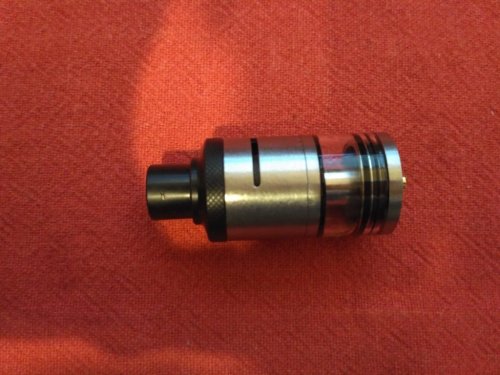
All naked and vulnerable. Ready for wire insertion.
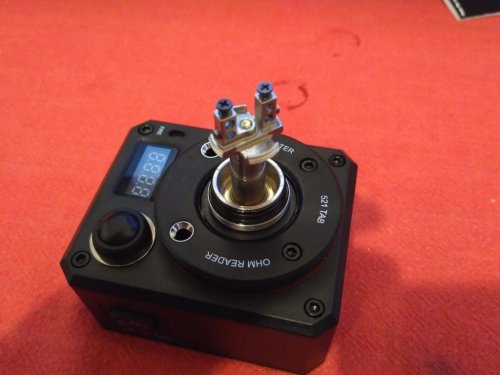
Lets do the twist baby. 28ga x3 kanthal at 3mm.
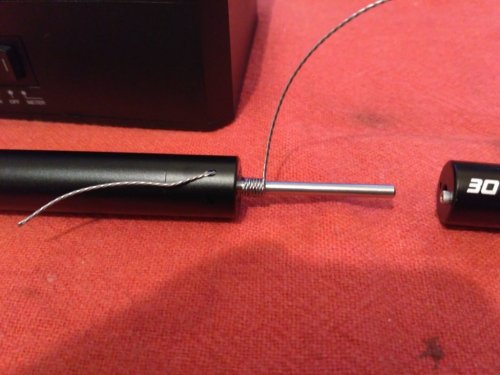
Six turns of goodness.
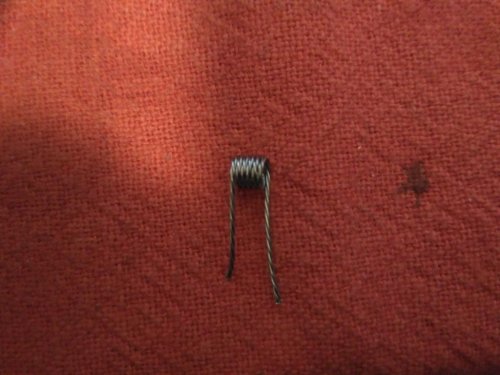
Those coils are as bent as our president. Some tweezers cheating in the future.
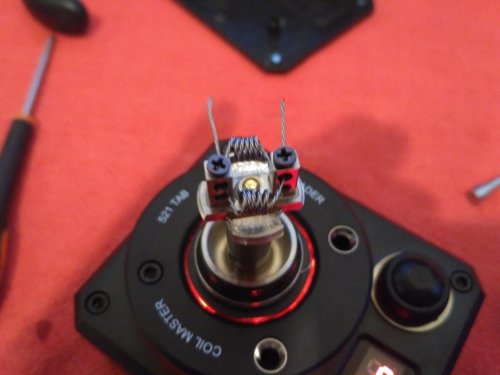
0.22 ohm of goodness.
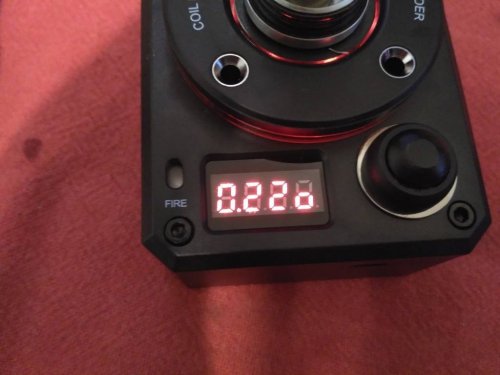
The promised tweezers cheating, bending, trying to get that professional YouTube look.
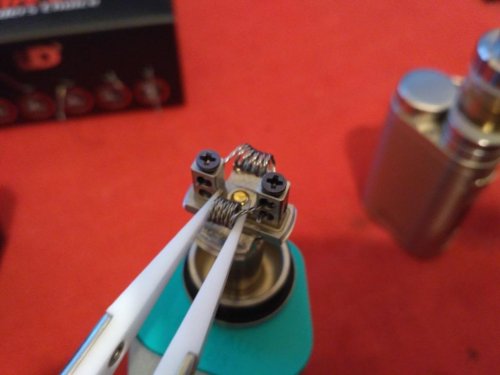
Movember mustachio glory
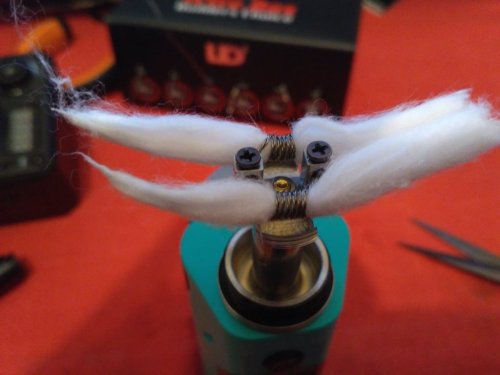
Fire in the hole.
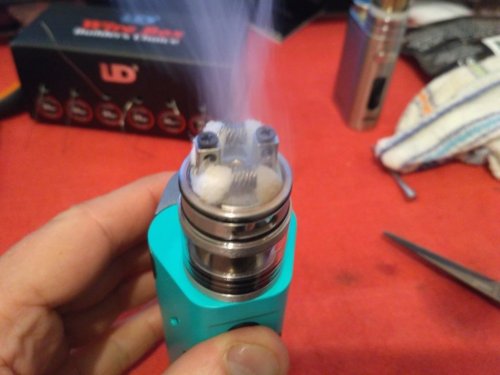
Three... Two... One...
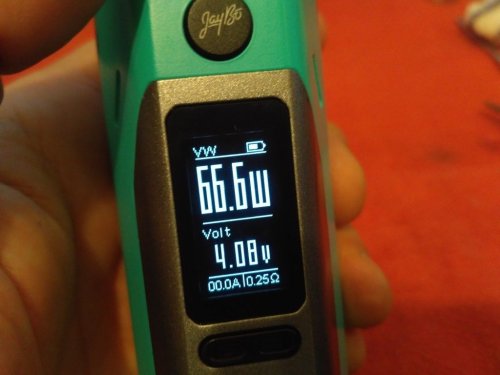
Lift of!
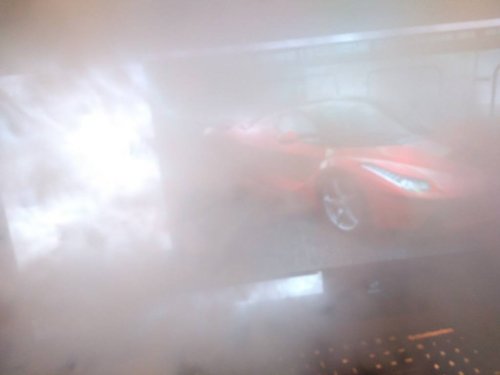
I would comment about the "flavour" and "fluffy little clouds". But I made the juice and have no idea what it really should taste like. So I'll settle for very satisfying...
I hated the paisley paint job, so now its home made brushed stainless.

All naked and vulnerable. Ready for wire insertion.

Lets do the twist baby. 28ga x3 kanthal at 3mm.

Six turns of goodness.

Those coils are as bent as our president. Some tweezers cheating in the future.

0.22 ohm of goodness.

The promised tweezers cheating, bending, trying to get that professional YouTube look.

Movember mustachio glory

Fire in the hole.

Three... Two... One...

Lift of!

I would comment about the "flavour" and "fluffy little clouds". But I made the juice and have no idea what it really should taste like. So I'll settle for very satisfying...
You put some power on that baby, Kayfuns never go out of style. I recently put some Clapton's on my k-6 (kaylantis) good times!Fun with a limitless RDA.
I hated the paisley paint job, so now its home made brushed stainless.
View attachment 75708
All naked and vulnerable. Ready for wire insertion.
View attachment 75709
Lets do the twist baby. 28ga x3 kanthal at 3mm.
View attachment 75710
Six turns of goodness.
View attachment 75711
Those coils are as bent as our president. Some tweezers cheating in the future.
View attachment 75712
0.22 ohm of goodness.
View attachment 75713
The promised tweezers cheating, bending, trying to get that professional YouTube look.
View attachment 75716
Movember mustachio glory
View attachment 75717
Fire in the hole.
View attachment 75718
Three... Two... One...
View attachment 75719
Lift of!
View attachment 75720
I would comment about the "flavour" and "fluffy little clouds". But I made the juice and have no idea what it really should taste like. So I'll settle for very satisfying...





Okay so this happened just now.
Dual wire @26ga spaced parallel coil @ 3.2mm ID in my merlin mini. Wire 1 = kanthal a1 and wire 2 = ni80. So far this is an amazing vape.
Sent from my iPad using Tapatalk
Similar threads
- Replies
- 2
- Views
- 2K
- Replies
- 5
- Views
- 2K
- Replies
- 3
- Views
- 475
- Replies
- 0
- Views
- 210


